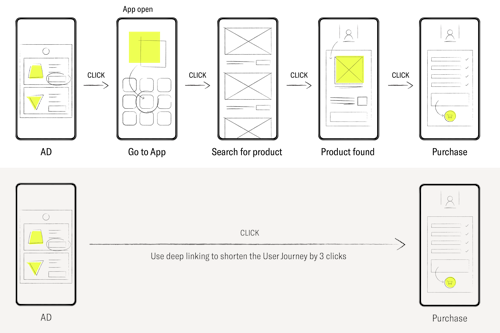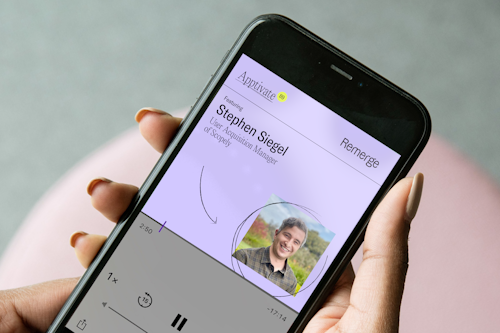Don’t miss out on mobile games app retargeting because of ATT
August 24, 2021

This article was inspired by an episode from Remerge’s Apptivate podcast featuring Ian Masterson, previously the Growth Marketing Manager at Tilting Point. Tilting Point is a free-to-play games publisher based in New York and has published popular titles such as “Spongebob Krusty Cook-Off” and “Star Trek Timelines”.
You can listen to episode 64 of the Apptivate Podcast through this link.
Retargeting can increase revenues events by 37%
There’s no doubt that the mobile games industry is thriving in spite of, but also because of, the COVID-19 pandemic. Data shows that mobile games generated a revenue of $77.2 Billion in 2020 alone, and it’s predicted to grow even more in the coming years. In 2021, for instance, consumers spent more than $116 billion globally inside mobile gaming apps.
While user acquisition remains the main growth tactic in most marketers’ playbooks, adding app retargeting into the mix can increase revenue events by 37% in the first 30 days, consequently maximizing the ROI of those newly-acquired users.
Get more ad clicks and re-engagements, despite ATT rollout
Since the launch of Apple’s App Tracking Transparency (ATT) framework, many marketers have become apprehensive about launching app retargeting. It might seem like a tactic that’s close to phasing out, but ID traffic remains high and retargeting users now will still result in a larger loyal customer base.

Source: Remerge performance data for Android retargeting campaigns
Even with the effects of the ATT framework our platform was able to deliver more clicks and re-engagements for our clients. We recorded 44% more clicks and 12% more re-engagement on Android for our gaming clients (Q1 2021 vs Q1 2022).
We’ve compiled a few tips to set you up for success when starting a re-engagement campaign in the post-ATT era.
Keep the user journey in mind for better conversion rates
Retargeting ads aim to bring the user back to where they left off, so that they can move to the next step of the purchase funnel. The next steps differ from app to app, but the most common examples for gaming apps include app open, sign-ups, playing to a specific level, purchasing something in-app, and repeating a purchase. Understanding the user journey is key to driving conversions, and doing so will enable you to deliver the right ad to the right person at the right time.
In order for retargeting to work effectively, the user’s experience of moving from the ad into the app must be seamless. Implementing deep links on Android and universal links on iOS will enable your ad to redirect the user to the right place.

For example, the user journey is vastly different between those who have the latest version of the app and those who do not. If a user hasn’t updated your gaming app, a deep link will redirect them to the app store or play store before they can get back into the app. Those who have the latest version will be redirected to the next step’s app page that you defined in the setup.
Target active players to improve retention and monetization
Retargeting the lapsed user segment is the most conventional form of re-engagement in the gaming space. Lapsed users are defined as players who have not used the app within a specific period of time, ranging from 7 to 30 days, sometimes more.
While many gaming apps are only interested in getting back lost users, there’s massive potential in retargeting users before they’ve lost interest. Expanding beyond the lapsed user group will improve overall retention and monetization. A 2019 Localytics survey shows that 25% of users abandon the app immediately after one use and re-engaging them while they still have interest can lower costs in the long run.
Retargeting users early in the process also increases the chances that this segment has the latest version of the app. This enables retargeting campaigns to perform optimally, as users will be redirected to parts of the app where they’re most likely to convert.
« An overall strategy to improve overall monetization and retention is getting those users in the first few days after install. »
Ian Masterson
App publisher Tilting Point has seen success with their non-players by giving them incentives to re-enter the app. They utilized app retargeting ads to remind users who have recently installed one of their gaming apps to interact with it. Retargeting ads were designed to help users get to a specific game level by giving them more time to overcome their current level but also to enjoy it.
Tilting point has also experimented with different ad formats, such as video. The company used video ads with hints about the game to help users complete levels they found difficult. They also highlighted new parts of the game to encourage users to update the app.
Take advantage of the situation while you can
App retargeting is a powerful strategy for engaging users across different markets and segments. By grouping users based on their activity level and showing them compelling and relevant creatives, you can improve the overall retention rates of your app which ultimately lead to higher ROAS.
As for retargeting users on iOS, ID traffic is still available at scale - more than 60% of global iOS bid requests come with an ID (June 2022). Take advantage of this transition phase by running experiments and harvesting insights that allow you to find the best ways to run no-ID campaigns in the future.
If you’re curious to learn more about when to use a third-party retargeting partner for mobile games marketing, read our other podcast episode recap featuring Pablo Bereskyji, Marketing Operations Manager at Etermax.





